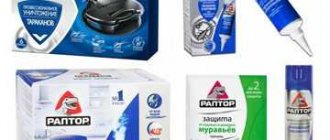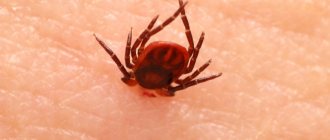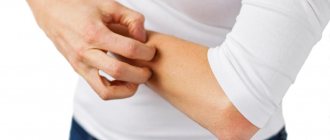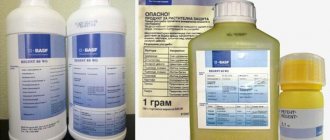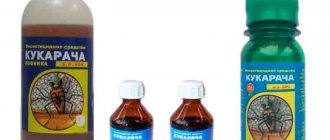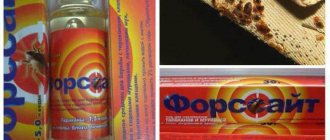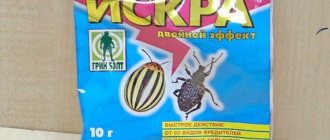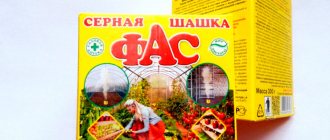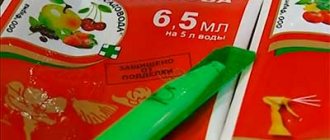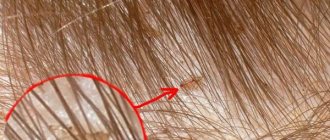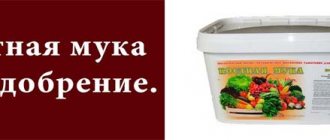Blockade Antiklop is a highly effective remedy for bedbugs, which is characterized by rapid action and long-term protection. This insecticidal preparation is mainly used by professional disinfection services, but it can also be used for self-treatment of premises.
The manufacturer of the product is the Russian scientific-commercial company. To ensure that the use of this insecticide is safe for human health and pets, you must strictly follow the instructions.
Composition and release forms
Blockade Antiklop is sold in plastic bottles of 50 ml and liter bottles. All information about the composition, instructions for use and precautions is provided on the label. The shelf life of the drug is 24 months from the date of release.
Release form
The active component of the drug is acetamiprid, which has a detrimental effect on bedbugs. The concentration of this substance in the product reaches 5%. The composition also includes functional additives that promote uniform distribution of the active component in the product and increase its effectiveness.
Composition, action
The active component of Blockade Antiklop against bedbugs is a new generation insecticide - the neonicotinoid acetamiprid, as well as functional additives that enhance the effect of the active substance. The product is classified as a moderately hazardous substance. When used correctly, it does not harm humans or animals.
How Blockade works Antiklop, like many other insecticides. Disturbs the functioning of the nervous system, blocks the transmission of impulses. Within a few seconds, paralysis and death occur. Penetrates into the body of a bedbug by contact, through spiracles on the chitinous cover.
Mechanism of action on bedbugs
The drug Blockade Antiklop has a contact effect. When it gets on the paws and body of an insect, the active component quickly penetrates and blocks the transmission of nerve impulses from the brain to the limbs. As a result, the parasites lose the ability to move and subsequently die. After contact with the insecticide, the insect remains active for some time and transmits the poison to other individuals, which leads to mass death of bed bugs.
The Antiklop Blockade agent has a detrimental effect on adults and larvae, but the active component is not able to penetrate the protective shell of the eggs. However, after treatment, the insecticidal effect of the drug lasts up to 3 weeks, which contributes to the death of young animals.
After disinsection, the first visible results are noticeable after 2 hours, and the maximum effect is achieved after 14 days.
What is the most effective remedy for bedbugs?
To successfully combat bed bugs, at least 2 treatments of the apartment with chemicals containing different active ingredients (AI) are required. DV should not only differ in name, but also be from different groups.
It is absolutely pointless to do even 2 treatments in a row with the same drug. Or 10 treatments with different drugs, but with the same active ingredient in the composition. Or simply belonging to one group.
For example, after treating an apartment with Medilis-anticlop (pyrethroids Permethrin + Cypermethrin + Tetramethrin), there is no need to use Tsifox (pyrethroid Cypermethrin) or catch up with Deltis (pyrethroid Deltamethrin). They all contain active substances of the same group - pyrethroids, and the desired effect will not be achieved. Although individually the listed drugs have excellent reviews. You just need to use them in accordance with the funds rotation schemes given below
Distribution of anti-bedbug products into groups
Based on the active substance, as already mentioned, all insecticides for killing bedbugs can be divided into 6 groups:
1. Organophosphorus compounds (OPS): malathion, fenthion, diazinon, chlorpyrifos, chlorophos.
2. Neonicotinoids: imidacloprid, acetamiprid, thiomethoxam.
3. Pyrethroids containing a CN group: permethrin, cypermethrin, alphacypermethrin, deltamethrin, lambda-cyhalothrin, zetacypermethrin, cyfluthrin.
4. Pyrethroids that do not contain a CN group: tetramethrin, imiprothrin.
5. Carbamic acid derivatives: propoxur, bendiocarb.
6. Combined preparations containing a pyrethroid and an active substance from the same (or another) group.
Characteristics of each group of drugs for removing bedbugs
Carbamic acid derivatives are extremely rare in bedbug killers and are 10 times less effective than other active ingredients. But as part of combination drugs they show good results.
Pyrethroids that do not contain a CN group cause hyperactivity of bedbugs and quickly decompose under the influence of the external environment.
Pyrethroids containing a CN group generally have a pleasant odor. But some of them may turn out to be extremely caustic at the time of processing. Particular care must be taken when working with lambda-cyhalothrin and using a gas mask that protects the respiratory system and the mucous membranes of the mouth and eyes. At the same time, lambda-cyhalothrin has proven itself to be excellent, safe after prolonged ventilation, and does not leave a pungent residual odor.
By the way, all drugs based on lambda-cyhalothrin are approved for use only by specialized services. And this is correct, knowing our “maybe”. It would not occur to employees of the disinfection services, when working with a poison of this class, to attach a cloth soaked in water to the face of the face, rather than a good gas mask. The exception is microencapsulated drugs, which do not have such an acute effect on humans due to the production technology of these drugs.
FOSs have a strong, persistent odor. Chlorpyrifos, including combination preparations, if it is included in their composition, is particularly caustic. In general, combination preparations most often have a strong odor, but have the maximum effect in killing bed bugs. Most formulations contain FOS + pyrethroid.
Treatments against bed bugs should be carried out alternating FOS, neonicotinoids and pyrethroids, including combination drugs in the rotation.
Preparation of the solution
The insecticide Blockade Antiklop should be used in diluted form. To prepare the working fluid, you need to dissolve 10 ml of the drug in 1 liter of cold water. One bottle of 50 ml is enough to treat 50 square meters. m.
Attention! When parasites multiply massively, the concentration should be doubled.
The solution must be prepared immediately before use. It should be used within 6 hours, as subsequently its insecticidal properties decrease. After adding the drug to the water, mix the solution thoroughly until a homogeneous consistency is obtained.
Precautionary measures
Store the pre-purchased product out of the reach of children, away from food and medicines.
The shelf life of the drug is no more than 2 years from the date of manufacture. It should be stored away from heating devices. The insecticide can withstand temperatures from 20°C cold to 40°C heat.
If safety rules are not followed, symptoms of poisoning may occur :
- dizziness;
- nausea;
- abdominal pain;
- unpleasant taste.
If your eyes are accidentally treated with an insecticide, you will need to rinse them with water for 5 minutes and apply eye drops. If it comes into contact with the body, rinse the contaminated areas in running water. If you feel dizzy and it becomes difficult to breathe, immediately go outside. Then rinse your nose and mouth with soda solution, take any sorbent. If the condition does not improve, consult a doctor.
Accidentally spilled product can be neutralized with bleach.
Application
According to the instructions for use, before carrying out disinfestation with the drug Blockade Antiklop, it is necessary to first prepare the room. To do this, you will need to vacuum and wet clean the apartment. It is necessary to remove flowers from the premises, remove animals, and cover aquariums.
It is also recommended to pack clothes and soft toys in plastic bags, food in airtight containers, and hide dishes in cabinets. It is necessary to remove curtains, tulle and bed linen, and then wash them at the maximum permissible water temperature.
Before processing, you should open sofas, armchairs, and also remove mattresses and paintings. All this is necessary to improve the product’s access to possible places where parasites accumulate. To increase the efficiency of disinfestation, it is recommended to close the ventilation hatches with gauze folded in several layers. This will prevent parasites from migrating to and from neighbors. Once preparation is complete, you can begin disinfestation.
Application
The insecticidal solution should be sprayed from a distance of 20 cm from the surface. The consumption rate is at least 100 ml per 1 sq. m. In places where bedbugs are concentrated, it is recommended to additionally treat the surfaces with a brush dipped in a solution.
When processing, special attention should be paid to:
- skirting boards;
- seams and folds of upholstery of upholstered furniture;
- reverse side of paintings, carpets;
- window frames;
- joints of interior parts;
- ventilation hatches;
- back walls of cabinet furniture;
- door frames;
- floor under the berths.
Disinsection can be carried out with the windows open, but upon completion, the room must be kept closed for 4 hours. Then you need to open the windows wide and ventilate the apartment for 2 hours. After this, you should wipe all working surfaces with a soap-soda solution, which will neutralize the effect of the insecticide.
Why are bedbugs difficult to kill?
The peculiarities of the life activity of bedbugs, their adaptability to any living conditions, as well as adaptation to the toxic components of common insecticides make the fight against these parasites tedious and lengthy.
An adult insect can remain in the stage of suspended animation for a year, and parasite eggs for up to two years. For successful and rapid reproduction of bedbugs, it is enough to have a food source and an air temperature above 16 degrees.
An accumulation of parasites is observed near the feeding source. It is these places that need to be given special attention when sanitizing the room against bedbugs:
- All the crevices of beds and sofas, especially the bottom of furniture.
- Hidden places in the seams of mattresses, pillows and blankets.
- Bedbugs love to hide under carpets and in the folds of upholstered furniture.
- Be sure to check all baseboards, especially near the bed and near radiators.
- Often parasites lay eggs in the far corners of wardrobes and the bottom of dresser drawers.
- Be sure to check all edges of the wallpaper. Parasites love to nest in paper shelters (books, posters on walls, loose edges of wallpaper).
Bedbug nests can be found between walls and old wallpaper
Important. Alternate insecticides to effectively kill parasites. Bedbugs quickly get used to the poison. The next generation of insects becomes immune to the action of chemical insecticides.
Security measures
Blockade Antiklop belongs to the category of chemicals of hazard class 3. When using this insecticide, you must follow personal safety rules. During disinsection, one person must be in the room.
According to the instructions for use, before using the drug Blockade Antiklop, you need to wear clothing that maximally covers exposed areas of the body, glasses, a respirator, and rubber gloves. During treatment you should not drink, smoke or eat.
If the solution gets on the skin or mucous membranes, it is recommended to immediately wash it off with plenty of water.
Attention! Ignoring personal safety rules can cause poisoning during disinfestation.
In this case, nausea, general weakness, and dizziness are felt. When these signs appear, you need to go out into the fresh air and drink activated carbon at the rate of 1 tablet per 10 kg of body weight.
Preparation
At the first stage, regardless of whether you invite a professional team (read more about bedbug extermination services here) or do the treatment yourself, inspect the premises in those places where family members spend the night.
These areas contain the maximum concentration of bedbug colonies: beds, sofas, bedside rugs, baseboards, heating appliances, window sills.
Their hiding places are cracks, loosely fitting upholstery, the back of carpets, loosely fitting wallpaper, and hollow baseboards. These are risk areas where residents do not periodically clean the premises and furniture.
At the second stage, you need to prepare the room for processing. Move all furniture away from the walls to make it easier to handle from the back. Remove bedding and underwear. Pack children's toys, dishes and food tightly and remove them from the treated area. All animals must be removed or removed during insecticide treatment. Seal the aquarium tightly and turn off the air supply to the aquarium.
The room must be processed using protective clothing:
- robe, suit;
- for the head, a scarf, a cap;
- rubber gloves;
- oilcloth apron;
- sleeves;
- respirator;
- protective glasses.
Attention. Work without a respirator is allowed if no more than 100 cm3 of the prepared solution is used per day.
In children's institutions, the preparation process is the same, and processing is carried out on sanitary days or weekends. In medical institutions, all patients are evacuated before disinfestation.
Advantages and disadvantages of the product
Antiklop Blockade has a number of advantages over other chemicals.
Main advantages:
- high efficiency;
- safety, subject to recommendations for use;
- lack of specific odor;
- long-term protective effect;
- ease of use;
- economical consumption;
- affordable price.
Flaws:
- with repeated treatments it causes addiction among parasites;
- requires preliminary preparation of the premises.
Blockade-anticlop where to process.
As you know, bedbugs live near their feeding area, and since they feed mainly at night and on our blood, we will look for them near our resting place.
- Crevices of beds, sofas and the bottom of furniture.
- Seams of mattresses, pillows, blankets.
- The backs of carpets, paintings and sconces.
- Pull-out shelves for bedside tables and chests of drawers.
- Gaps in baseboards and heating radiators.
- Gaps between wallpaper and loose edges.
- Bedside switches and sockets (disconnect power in advance).
Conclusions from Tikhon: Anti-bug blockade is an effective modern remedy in the fight against bed bugs. With the correct dosage, it does not require re-processing, low consumption, availability.
If you have experience using this tool, please leave your comment. Perhaps he will help someone make the right choice in the fight against bedbugs.
Happiness to you and your home.
Positive reviews about the drug
The insecticide “Medilis Antiklop” has mostly positive reviews from users. Thus, many note that if a problem is noticed in time, then one spray treatment is enough to eliminate it. Users also appreciated the convenient and economical bottle. The effect of the procedure is immediate and nothing else needs to be done.
Many users note that only this remedy helped get rid of the problem. If other drugs were used before, the effect was either incomplete or short-lived. The bugs disappeared, but then appeared again. But Medelis Antiklop helps to quickly and effectively rid any room of harmful insects.
Types of therapeutic and diagnostic blockades
Local
The injection is made into the affected area, under or around the lesion, into the area of altered tissue reactions, into inflammation, etc. They are divided into periarticular (in the tissue near the joints) and perineural (into the nerve canals).
Segmental
Injections into various segments, these include paravertebral blockades, which are given in the projection of segments of the spine. Each spinal nerve and spinal segment corresponds to a dermatome (a section of the skin, connective tissue), a sclerotome (an area of the skeletal system), and a myotome (part of the muscular system). By injecting the drug intradermally into any dermatome, it is possible to influence the corresponding part of the spine and/or internal organ. The most common indication is myotonic reactions of paravertebral muscles in osteochondrosis.
Vertebral
This therapeutic blockade combines several techniques in neurology. Used for back pain. The anesthetic can be injected intradermally, between the spinous processes of the vertebrae to a depth of 2-4 cm, into the area of the vertebral body. In the latter case, they retreat 3-4 cm to the side from the line of the spinous processes. The needle is directed at an angle of 35° and inserted 8-10 cm in depth.
Spinal blocks
Severe pain in the spine is associated with pinched spinal nerves. The blockade acts in a targeted manner and normalizes well-being. This is not a simple procedure, so it is carried out only as a last resort.
During the blockade, the nerve conduction of certain fibers is temporarily switched off. To do this, local anesthetics are used, which block cellular conduction by inhibiting voltage-dependent sodium pathways.
The procedures are indicated for disc protrusion, osteochondrosis, neuralgia, intervertebral hernia, myositis, spondyloarthrosis. Spinal blocks are cervical, thoracic, thoracolumbar, sacrolumbar, coccygeal, paravertebral. The latter are divided into intradermal and subcutaneous (numb the skin near the spine), intramuscular (relieve muscle spasm and inflammation), perineural ("turn off" the affected nerve).
The effect occurs in a few minutes. At the same time, vascular spasm is reduced, tissue restoration is accelerated, metabolism is normalized, and swelling from inflammation goes away.
Heel spur blocks
Used to relieve inflammation of the heel fascia. The injection is made into the heel spike, in the very center. Hormone-based medications are used. The effect is instant. The difficulty lies in the bone-salt structure of the spine, which complicates the process. The doctor must be highly qualified and experienced. Steroids not only relieve inflammation, but also “accelerate” metabolism. Due to the latter, the bone growth is reabsorbed. Most often, one of three glucocorticosteroids is used: Hydrocortisone, Diprospan or Kenalog. The effectiveness of the method depends 90% on the correct injection. Therefore, the procedure is carried out under ultrasound control. It is extremely painful, so local anesthesia with Ultracaine, Novocaine or other similar medicine is first provided. After the injection, do not step on your heel for 30-60 minutes. Next, to reduce pressure on the heel fascia, special insoles are used.
Joint blocks
They are used for small and large joints when pain is a consequence of a degenerative process or inflammation. The anesthetic is injected into the joint capsule. After this, the pain is completely eliminated. If the case is advanced, then it is significantly reduced. The main indications are bursitis, osteoarthritis of the joints, periarthritis, arthritis of a non-infectious nature, tenosynovitis. The procedure does not require preparation and is performed under local anesthesia. Duration – 20 minutes. The effect occurs within a few minutes. Immediately after administration of the drug, you can move. The duration of the effect depends on the degree of damage to the joint. It averages 21 days. Then repeated blockades are made. Sometimes injections are made not into a joint, but into a muscle. This is necessary to reduce the spasm that causes pain. This group also includes paravertebral blockades. The following joints are treated using this technology: ankle, hip, wrist, knee, shoulder, elbow.
Nerve blocks
An anesthetic is injected into the area along which the peripheral nerve travels. This eliminates pain, vascular spasm, muscle tension, inflammation and swelling. Indications: neuritis, neuralgia, oncology, joint pathologies, muscular-tonic and tunnel syndromes. The procedure can be performed under ultrasound guidance. Duration – up to 10 minutes. The analgesic effect occurs within a few minutes and lasts up to 21 days. Repeated procedures can be performed, except in cases where the effect does not occur after 1-2 injections.
Features of the insecticide
The drug in question is the latest development of Russian scientists. The composition is created in such a way that it acts on the insect at any stage of its development. It is known that bedbug eggs and larvae are protected by a special chitinous layer and are difficult to influence. “Medilis anticlop” (reviews confirm this) is capable of destroying not only adult individuals, but also affects their offspring.
A situation often arises when parasites develop strong immunity to an insecticide. The remedy for bedbugs "Medilis anticlop" is not persistently addictive, so it can be used repeatedly with equal success. Thanks to this, the drug causes a lasting effect, it is recognized as the most effective.
Indications for therapeutic blockade
- pain in the neck, back;
- osteochondrosis;
- neuralgia, neuritis;
- pain in the spine due to intervertebral hernia;
- rheumatism;
- osteoarthritis;
- pain in the postoperative period;
- phantom pain;
- Minière's syndrome;
- neuropathy;
- spasticity;
- amputation pain;
- pain and spasticity after a stroke;
- radiculitis;
- migraine;
- sciatica;
- tunnel syndrome.
"Medilis antiklop": description of the product
The drug is available in a convenient spray format, which is completely ready for use and does not require dilution. It is a slightly yellowish liquid. It has been proven that once on a surface, the spray retains its unique toxic properties for up to two months. As a result, the possibility of reproduction and appearance of large individuals in the room is completely excluded. As soon as a new insect emerges from the eggs, it immediately becomes infected and dies.
If you directly treat the larvae, they will no longer mature and the bug will not hatch from them. The product is capable of removing not only several nests of parasites, but also large populations. Customer reviews available on “Medilis Antiklop” prove its effectiveness in case of large infestation of a living space and in a single case of their occurrence.
The drug, as already mentioned, is a development whose products have long been known for their effectiveness and have proven themselves to be completely effective. It is known that the company’s products are used even by professional disinfectors, whose services are used by hotel owners, as well as those living in hostels and apartments of old housing stock.
Preparatory activities
When using the Medilis Antiklop spray, precautions must be taken. Before treatment, it is necessary to temporarily remove all people from the premises, as well as animals. You cannot leave aquariums, cages with birds and rodents, or other pets in the apartment. Next, you need to remove and seal the dishes, kitchen utensils, cosmetics and clothing.
Bed linen, bedspreads and curtains cannot be treated with the product. It is enough to wash them at the highest possible temperature with the addition of disinfectants, then iron them on both sides.
Before applying the insecticide, it is recommended to do a wet cleaning so that the spray settles on clean surfaces and not on dust and dirt. Otherwise, the liquid quickly disappears and its effectiveness decreases. It is advisable to move cabinet furniture away from the walls and vacuum it. If possible, upholstered furniture should also be treated with steam.
Windows and doors must be closed before treatment. It is important to use personal protective equipment. Moreover, a gauze bandage will not protect against toxic fumes, so it is recommended to use a high-quality respirator. You need to cover your clothes with an old raincoat, raincoat or thick robe, which will have to be thrown away after the procedure. You will also need gloves and safety glasses.
Of course, the procedure for getting rid of bedbugs is quite troublesome, but if you use Medelis Antibed, then one such event is enough.
Disadvantages of the drug
The spray also has disadvantages. Many people complain about its strange smell, which even after airing lasts for a very long time. Of course, such a phenomenon can happen, because it contains three strong toxic substances, but the vapors have no effect on humans after ventilation.
Also, some are not happy that bedbugs not only disappear, but die. As a result, it takes a long time to discover their corpses, which is not always pleasant. In addition, they can be located in the corners of upholstered furniture. In this case, it is recommended to do a thorough cleaning after treatment.
